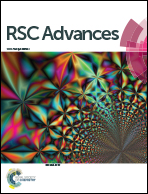Novel organic sensitizers containing dithiafulvenyl units as additional donors for efficient dye-sensitized solar cells
Abstract
In order to increase the electron-donating ability of the donor part of the organic dye, the dithiafulvenyl (DTF) group as an additional electron donor is introduced into a triphenylamine (TPA) unit to form a donor–donor (2D) structure in this paper. Two new organic dyes WD9 (one 2-cyanoacetic acid as an electron acceptor) and WD11 (two 2-cyanoacetic acids as electron acceptors) containing this DTF–TPA 2D structure are designed, synthesized and applied in dye-sensitized solar cells (DSSCs). It is found that the double donor structures (DTF–TPA) not only contribute to enhancement of the electron-donating ability, but also inhibit aggregation between dye molecules and prevent I3− in the electrolyte from recombining with injected electrons in TiO2. Under AM 1.5G irradiation (100 mW cm−2), a maximum power conversion efficiency (η) of 4.09% is obtained for the WD11-based DSSC, higher than that of DTF-free dye L0 (η = 2.47%). These results have demonstrated that the incorporation of the DTF group into the organic dye will be an effective approach to develop high-performance metal-free organic dyes.


 Please wait while we load your content...
Please wait while we load your content...